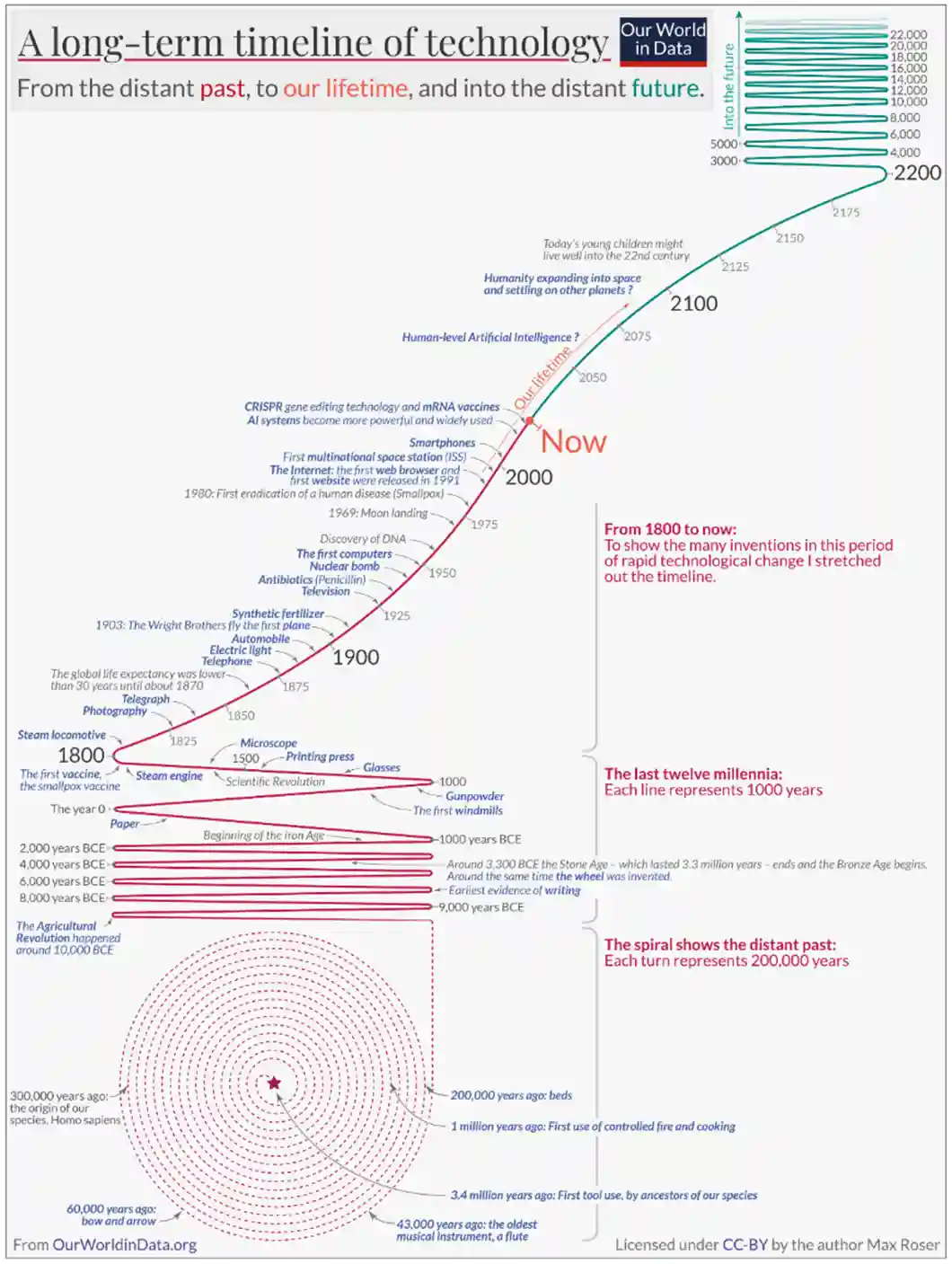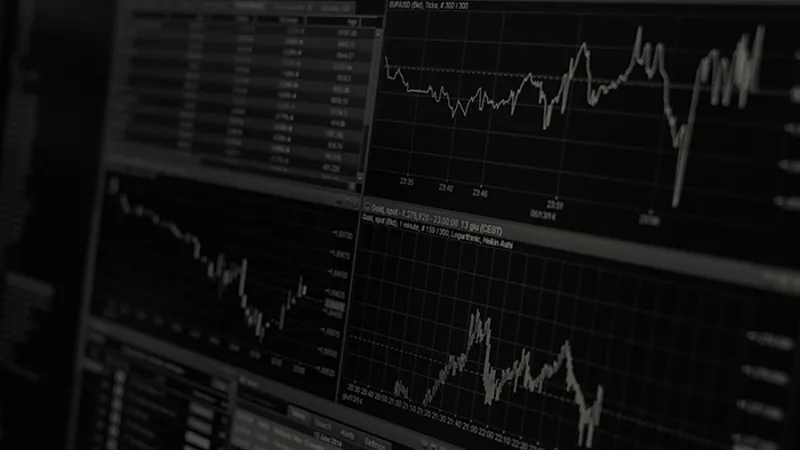For most of human history, technological progress has been slow and predictable. Generations lived and died using the same tools. The leap from stone tools to controlled fire took millions of years. Even after that, breakthroughs like agriculture, writing, and the wheel were separated by thousands of years.
Then came the industrial and digital revolutions. The pace accelerated dramatically: the Wright brothers’ first powered flight in 1903 was followed by the moon landing just 66 years later. Communication evolved from handwritten letters to smartphones in barely a century.

Artificial intelligence represents the next great leap, and it’s unlike anything before. Why? Because intelligence has always been the engine of innovation. Now, we’re creating systems that can amplify or even outperform human intelligence in specific tasks. That means decades-long innovation cycles could compress into years or even months.
AI at Work
The conversation around AI in the workplace is impossible to ignore, with headlines often warning that machines are coming for our jobs. While AI is undeniably the most transformative technological advancement of our time and will reshape the future of work, the reality is more nuanced.
Right now, most companies are using AI to make workdays easier, not to replace workers already on their payroll. Copilots and chatbots handle repetitive tasks like drafting emails, summarizing documents, and answering routine questions. It’s about efficiency, not a total overhaul.
But there is an additional AI shift underway: Agentic AI. These systems do more than wait for instructions. They can plan, act, and adapt across entire workflows. Imagine an AI that monitors dashboards, triggers follow-ups, and coordinates projects with minimal human input. For employees, that means less time spent on repetitive work and more time for high-value tasks. For companies, this means less friction and more profitability.
This is where automation and augmentation come into play. Automation passes off routine, rules-based work to machines, cutting costs and reducing errors. Augmentation helps people be more productive, by analyzing data faster, making more informed decisions, and delivering better results. Most companies find that a mix of both automation and augmentation works best. Automation brings quick efficiency gains, while augmentation supports long-term growth and innovation.
The Changing Labor Market
AI isn’t just driving workplace efficiency. It’s also reshaping the labor market on a macro level. Corporations are increasingly redirecting capital toward AI investments rather than expanding headcount. Research from Stanford and Harvard shows that employment for young professionals in AI-exposed roles has dropped by more than 10% since late 2022.
That said, jobs aren’t disappearing across the board. Instead, AI is absorbing many of the foundational tasks traditionally handled by junior employees, while senior strategic roles remain largely intact, for now. What we are seeing right now is consistent with other inflection points in technological advancement, and it’s important to keep a long-term perspective. Historically, technological innovation has created more jobs than it has displaced. In fact, about 60% of today’s jobs didn’t exist in 1940, largely because work evolves as new tools and technologies emerge. We’re still in the early innings of the AI buildout, and new roles are likely to emerge—particularly in areas like regulation, data privacy, AI infrastructure, and human-AI collaboration.
What makes this moment especially significant is that AI-driven disruption is unfolding alongside major global demographic shifts: an aging population and slower population growth. With population growth having peaked nearly six decades ago, future economic expansion will rely more heavily on productivity gains. AI can help offset the associated labor market pressures by increasing output per worker through optimizing workflows and freeing up time for higher-impact responsibilities.
Ultimately, as AI adoption accelerates and demographic headwinds persist, the key question shifts from How many people are working to How efficiently can labor and capital be converted into output?
That’s where the concept of total factor productivity (TFP) comes in.
Why Productivity Is the Real Story
In an AI-driven economy, metrics like total factor productivity (TFP) become the critical measure of progress. TFP captures the gains achieved through innovation and smarter ways of working rather than simply adding more labor (workers) or capital (tools). Both labor and capital face natural constraints: there is a finite number of people to employ and diminishing returns to deploying additional capital. What ultimately matters is an organization’s ability to generate more output with the resources it already has. When companies succeed in improving productivity, they not only produce more with fewer inputs but also reduce unit costs, which helps contain prices. In today’s environment, where sticky inflation remains a concern, AI-driven productivity has the potential to act as a stabilizing force by easing cost pressures while supporting economic growth.
Japan offers a clear example of why productivity matters. The OECD projects that Japan’s working-age population will shrink by 31% by 2060, one of the steepest declines among developed economies. To address this, Japan is leaning heavily on AI and robotics to close the productivity gap left by its shrinking labor force. In agriculture, for instance, companies like Kubota are developing fully automated, uncrewed machinery to offset labor shortages. For a country facing such a sharp demographic decline, technology isn’t optional; it’s essential to sustaining economic momentum.
This urgency extends far beyond Japan. Countries worldwide are racing to integrate AI, robotics, and advanced technologies to unlock their full economic potential. But adoption alone isn’t the finish line. The real measure of success will be whether these innovations translate into an acceleration of GDP growth via productivity gains, which can be measured at the individual, corporate, and macroeconomic levels.
Stay in the Know
While this third installment of our AI blog series was focused primarily on the impact of AI labor markets and the macro economy, our previous blogs focused on other key facets of the AI buildout. You can catch up on the previous blogs at the links below:
- The AI Revolution: What Every Investor Should Know
- The AI Revolution: How AI is Showing Up in Markets and Portfolios
Stay tuned for more insights from the Wealthspire team.
Sources:
- Managing Japan’s Shrinking Labor Force With AI and Robots - IMF F&D Magazine - June 2018 | Volume 55 | Number 2
- AI and Robotics Usher in a New Age for Agriculture | The Government of Japan - JapanGov –
- MIT News
- Technical Change and the Aggregate Production Function on JSTOR
- https://www.oecd.org/en/publications/oecd-employment-outlook-2025-country-notes_f91531f7-en/japan_7672bd00-en.html
- https://ourworldindata.org/technology-long-run
- Back to Basics: Total Factor Productivity
- Global population growth peaked six decades ago - Our World in Data
Wealthspire Advisors LLC, Fiducient Advisors LLC, Wealthspire Retirement, LLC dba Wealthspire Retirement Advisory, and certain other affiliates are separately registered investment advisers.
This material should not be construed as a recommendation, offer to sell, or solicitation of an offer to buy a particular security or investment strategy. The information provided is for informational purposes only and should not be relied upon for accounting, legal, or tax advice. While the information is deemed reliable, Wealthspire Advisors cannot guarantee its accuracy, completeness, or suitability for any purpose, and makes no warranties with regard to the results to be obtained from its use.


